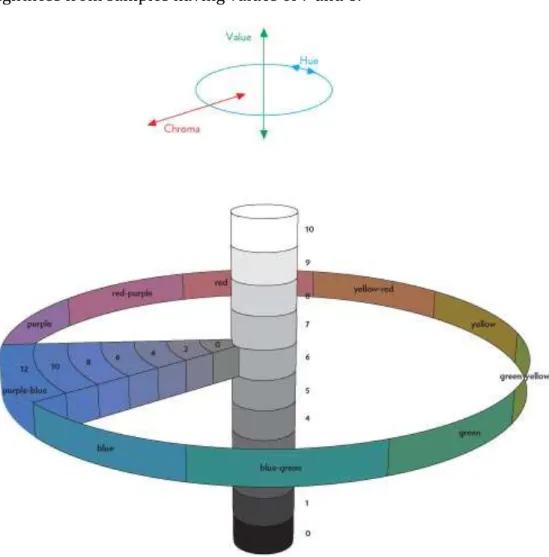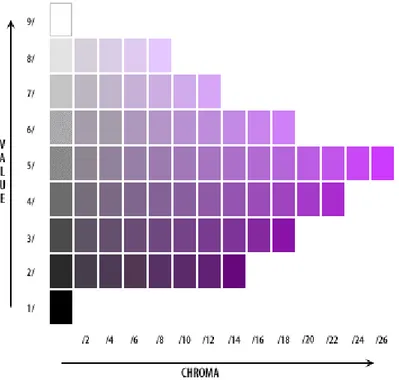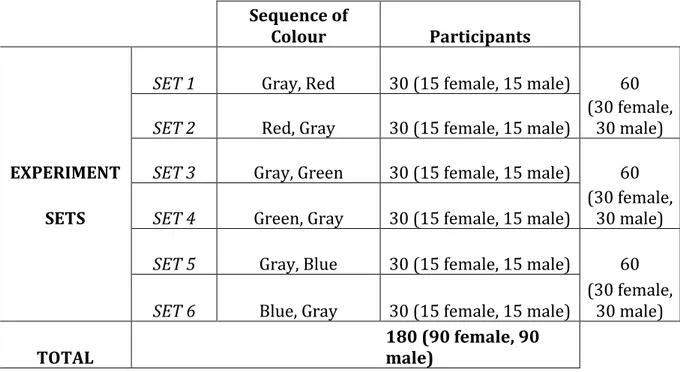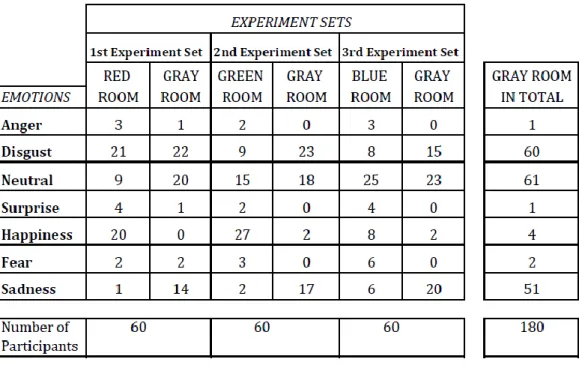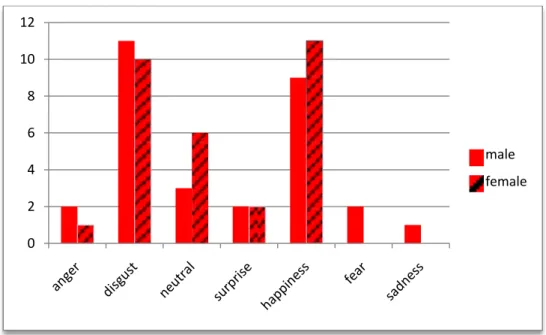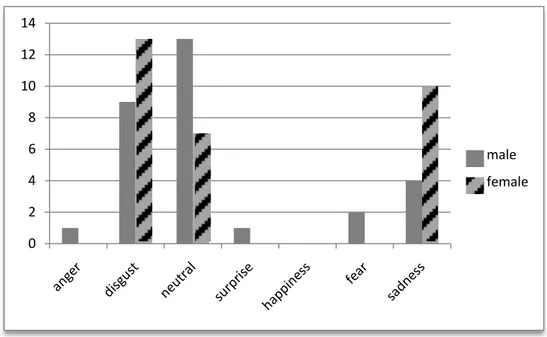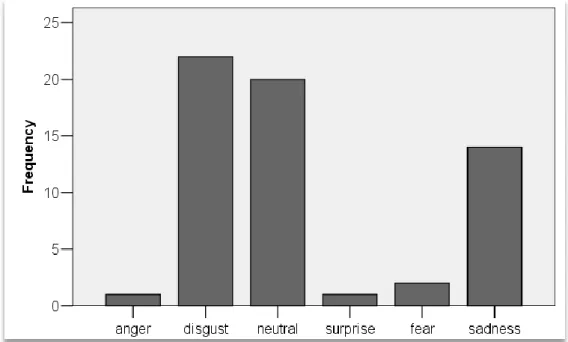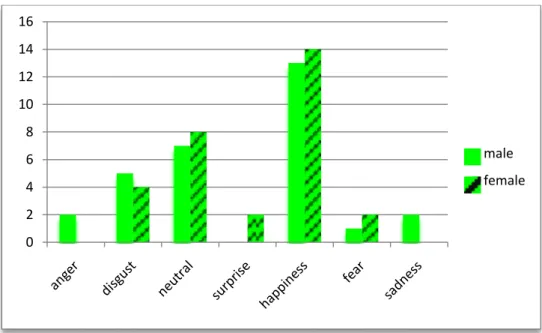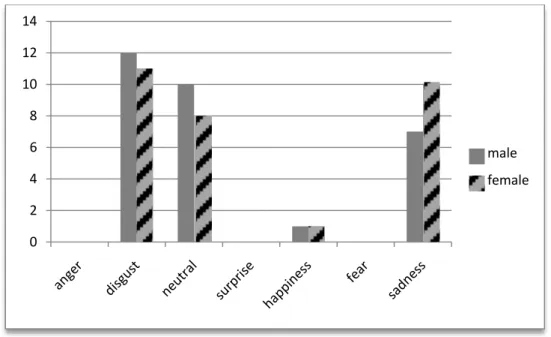COLOUR-EMOTION ASSOCIATIONS
IN INTERIOR SPACES
A DISSERTATION
SUBMITTED TO THE DEPARTMENT OF
INTERIOR ARCHITECTURE AND
ENVIRONMENTAL DESIGN AND THE GRADUATE
SCHOOL OF ECONOMICS AND SOCIAL
SCIENCES OF İHSAN DOĞRAMACI BİLKENT
UNIVERSITY
IN PARTIAL FULFILLMENT OF THE
REQUIREMENTS
FOR THE DEGREE OF
DOCTOR OF PHILOSOPHY
IN ART, DESIGN AND ARCHITECTURE
By
Elif Helvacıoğlu
July, 2011
To my parents Oya & Kadir Helvacıoğlu
COLOUR-EMOTION ASSOCIATIONS
IN INTERIOR SPACES
A DISSERTATION
SUBMITTED TO THE DEPARTMENT OF
INTERIOR ARCHITECTURE AND
ENVIRONMENTAL DESIGN AND THE GRADUATE
SCHOOL OF ECONOMICS AND SOCIAL
SCIENCES OF İHSAN DOĞRAMACI BİLKENT
UNIVERSITY
IN PARTIAL FULFILLMENT OF THE
REQUIREMENTS
FOR THE DEGREE OF
DOCTOR OF PHILOSOPHY
IN ART, DESIGN AND ARCHITECTURE
By
Elif Helvacıoğlu
July, 2011
iii
ABSTRACT
COLOUR-EMOTION ASSOCIATIONS IN INTERIOR SPACES
Elif Helvacıoğlu
Ph.D. in Art, Design and Architecture Supervisor: Assist. Prof. Dr. Nilgün Olguntürk
July, 2011
Colour as an effective design tool influences people’s emotions in interior spaces. Depending on the assumption that colour has an impact on human psychology, this study stresses the need for further studies that comprise colour and emotion association in interior space in order to provide healthier spaces for inhabitants. Emotional reactions to colour in a living room were investigated by using self report measure. Pure red, green and blue were chosen to be
investigated as chromatic colours, whereas gray was the achromatic colour used as a control variable. The study was conducted at Bilkent University in Ankara, Turkey. Hundred and eighty people from various ages and academic
departments participated in the study. Participants first watched a short video showing an overlook of a 3D model of a living room. Next, they were asked to match the distinct coloured living rooms with facial expressions of six basic emotions that covers anger, disgust, surprise, happiness, fear, sadness and in addition with neutral. The results of the study indicated that the most stated emotions associated for the room with red walls were disgust and happiness, while the least stated emotions were sadness, fear, anger, and surprise. Neutral and happiness were the most stated emotions for the room with green walls and anger, surprise, fear and sadness were the least stated ones. The most stated emotion associated for the room with blue walls was neutral, while the least stated emotions were anger and surprise. Neutral, disgust and sadness were the most stated emotions for the room with gray walls. Gender differences were not found in human emotional reactions to living rooms with different wall colours.
iv
ÖZET
İÇ MEKÂNLARDA RENK-DUYGU İLİŞKİLENDİRMELERİ
Elif Helvacıoğlu
Güzel Sanatlar, Tasarım ve Mimarlık Fakültesi Doktora Çalışması
Danışman: Yrd. Doç. Dr. Nilgün Olguntürk Temmuz, 2011
Renk, etkili bir tasarım aracı olarak, iç mekânlarda insanların duygularını etkiler. Rengin insan psikolojisine etkisi olduğu varsayımına dayanarak, bu çalışma insanlara daha sağlıklı mekânların sağlanması için, iç mekânlarda renk ve duygu ilişkisine dair çalışmaların geliştirilmesi gerekliliğini vurgular. Oturma odalarında renge verilen duygusal tepkiler özbildirim ölçekleri kullanılarak incelenmiştir. Çalışma için kromatik renkler olarak saf kırmızı, yeşil ve mavi seçilmiş iken, akromatik renk olarak gri kontrol değişkeni olarak kullanılmıştır. Çalışma Bilkent Üniversitesi, Ankara, Türkiye’de yürütülmüştür. Çalışmaya farklı yaş ve akademik bölümlerden olmak üzere yüz seksen kişi katılmıştır. Katılımcılara öncelikle 3 boyutlu olarak modellenmiş bir oturma odasına bakışı gösteren kısa bir video izlettirilmiştir. Daha sonra katılımcılardan farklı
renklerdeki oturma odalarını kızgınlık, iğrenme, şaşkınlık, mutluluk, korku, üzüntü ve ek olarak nötr duygularını temsil eden yüz ifadeleri ile eşleştirmeleri istenmiştir. Çalışma sonuçlarına göre kırmızı duvarlı oda ile en çok eşleştirilen duygular iğrenme ve mutluluk iken, en az eşleştirilen duygular üzüntü, korku, kızgınlık ve şaşkınlıktır. Nötr ve mutluluk, yeşil duvarlı oda ile en çok
eşleştirilirken, üzüntü, korku, kızgınlık ve şaşkınlık en az eşleştirilen duygulardır. Mavi duvarlı oda ile en çok eşleştirilen duygu nötr iken, en az eşleştirilen duygular kızgınlık ve şaşkınlıktır. Nötr, iğrenme ve üzüntü gri duvarlı oda ile en çok eşleştirilen duygulardır. Farklı duvar renklerindeki oturma odalarına verilen duygusal tepkilerde cinsiyete dayalı farklılıklar bulunmamıştır.
v
ACKNOWLEDGEMENTS
I am heartily thankful to my advisor Assist. Prof. Dr Nilgün Olguntürk who introduced me into a colourful world. I would like to express my gratitude to her for the continuous support of my Ph.D. study and research from the initial to the final level. Without her motivation, enthusiasm, and immense knowledge, this dissertation would not have been possible. I wish to keep up any
collaboration in our colourful world in the future.
I am honoured to thank my committee member Prof. Dr. Halime Demirkan whose encouragement, advice and crucial contribution throughout my graduate and Ph.D. studies I will never forget. I wish also show my appreciation to
Assoc. Prof. Dr. Çiğdem Erbuğ as another member of my committee for her valuable and generous suggestions during the preparation process of this dissertation.
I owe my deepest gratitude to Assist. Prof. Dr. Meltem Gürel and Assist. Prof. Dr. Güler Ufuk Demirbaş, for their critical comments regarding the finalization of the dissertation. Besides, I would like to express my appreciation to Dr. Dilek Güvenç for her suggestions throughout the statistical analyses of the thesis. I would like to extend my heartfelt gratitude to my dearest friend Segah Sak who patiently was with me from the very beginning of my academic adventure. You were such a wonderful motivator even when coping seemed tough for me. I will never forget out entertaining conversations that evoked wonderful ideas. I owe my gratitude to İnci Cantimur for patiently helping me to create the virtual spaces for my study. In addition, special thanks go to Aslı Çebi, Seden Odabaşıoğlu and Nalan İnalhars for their friendship and moral support. My deepest gratitude goes to my parents Oya and Kadir Helvacıoğlu for their unconditional support. I am very honoured and lucky to have you as my parents. Thank you for giving me chances to prove and improve myself through all my walks of life. Moreover, I would like to give my sincere thanks to my wonderful family Cem and Didem Helvacıoğlu, Sibel and Bahtiyar Yıldız for their invaluable support and trust.
Last but not least, I am greatly indebted to my fiancé Alpaslan Güneş for his unflagging love, trust and encouragement in my life. You will always be the most special of my life.
vi
TABLE OF CONTENTS
SIGNATURE PAGE ...ii
ABSTRACT ...iii
ÖZET ...iv
ACKNOWLEDGEMENTS ...v
TABLE OF CONTENTS ...vi
LIST OF TABLES ...x
LIST OF FIGURES ...xv
1. INTRODUCTION 1
1.1. Aim of the Study ...3
1.2. The General Structure of the Dissertation ...4
2. EMOTION 6
2.1. About Emotion ...6
2.1.1. Definition of Emotion ...6
2.1.2. Related Phenomena ...7
2.1.3. Emotion States and Traits ...10
2.2. Process of Emotion ...11
2.2.1. The Category of Emotion ...11
2.2.2. Components of Emotions ...13
2.2.3. The Sequence of Emotion ...18
2.3. Influences of Emotion on Human Beings ...22
2.4. Universals of Emotion ...25
2.5. Measuring Emotion ...26
2.5.1. Self Reports of Subjective Experience ...28
vii
2.5.3. Facial Measures of Emotion ...39
2.5.4. Vocal Measures of Emotion ...40
2.5.5. Physiological Measures of Emotion ...41
3. COLOUR BASICS 43
3.1. Colour: A Definition ...43
3.2. Basic Colour Terminology ...44
3.3. Colour Order Systems ...45
3.3.1. Munsell Colour System ...46
3.3.2. Natural Colour System (NCS) ...51
3.3.3. CIELAB ...56
3.3.4. RGB Colour Model ...61
3.4. The Nature of Colour ...66
3.4.1. Colour in Physiology ...66
3.4.2. Colour in Psychology ...68
4. COLOUR AND EMOTION 69
4.1. Symbolic Associations of Colour – Colour Meanings ...69
4.2. Empirical Implementations of Colour and Emotion ...76
5. COLOUR, INTERIOR SPACE AND EMOTION 84
5.1. Interior Space ...84
5.2. Emotional Response to Colour in Interior Spaces ...85
6. THE EXPERIMENT 88
6.1. Aim of the Study ...88
6.1.1. Research Questions ...89
6.1.2. Hypotheses ...89
6.2. Method of the Study ...90
viii
6.2.2. Setting Description ...92
6.2.3. Procedures ...96
6.2.3.1. Selecting the Function ...96
6.2.3.2. Specifying the Colours ...98
6.2.3.3. Creating the Interior Space ...100
6.2.3.4. Phases of the Experiment ...101
7. FINDINGS 105
7. 1. 1st Experiment Set – Red Room ...107
7.1.1. Red Room ...107
7.1.2. Gray Room ...110
7.2. 2nd Experiment Set – Green Room ...112
7.2.1. Green Room ...113
7.2.2. Gray Room ...115
7.3. 3rd Experiment Set – Blue Room ...118
7.3.1. Blue Room ...118 7.3.2. Gray Room ...120 8. DISCUSSION 123 9. CONCLUSION 131 REFERENCES 136 APPENDICES 146 APPENDIX A. Descriptions and Images of Action Units Defined in the Facial Acton Coding System (FACS) by Paul Ekman, Wallace V. Friesen ...146
Appendix A1. Descriptions and Images of Action Units ...147
Appendix A.2. Prototypical Patterns of Facial Expressions of Basic Emotions ...154
ix
APPENDIX C. Setting of the Experiment ...157
APPENDIX D. Interior Spaces Used in the Experiment ...159
APPENDIX E. The Questionnaire ...162
Appendix E.1. The Questionnaire (in Turkish) ...163
Appendix E.2. The Questionnaire (in English) ...165
APPENDIX F. Information about the Study ...167
Appendix F.1. Information about the Study (in Turkish) ...168
Appendix F.2. Information about the Study (in English) ...169
APPENDIX G. Facial Expressions of Basic Emotions used in the Experiment ...170
x
LIST OF TABLES
Table 4.1. Emotional associations of colour in the literature ...83
Table 6.1. Distribution of the departments ...91
Table 6.2. Selected colours from RGB additive colour model ...100
Table 6.3. Experiment sets showing the number of participants with the sequence of colours ...103
Table 7.1. The frequency distribution of emotions on the coloured rooms ...106
Table 8.1. Mostly associated emotions with gray room ...129
Table 8.2. Mostly associated emotions with chromatic rooms ………..129
Table 9.1. Mostly associated emotions with living rooms ...135
Table A.1. Descriptions and images of action units ...147
Table A.2. Prototypical patterns of facial expressions (Ekman and Friesen, 1978) ...154
Table B.1. Descriptive statistics showing the mean age of the sample group ...156
Table B.2. Sample’s distribution on the basis of age ...156
Table B.3. Computer usage of the sample group ...156
Table B.4. Computer Usage Frequency of the sample group ...156
Table H.1. Statistics of the sequence of showing coloured room for red room ...173
Table H.2. Independent Samples t-Test results for sequence differences on emotional reactions to red room ...173
xi
Table H.3. Statistics for gender differences for red room ...173 Table H.4. Independent Samples t-Test for gender differences on emotional
reactions to red room ...173 Table H.5. Frequency of emotions associated with red room in respect to
male gender group ...174 Table H.6. Frequency of emotions associated with red room in respect to
female gender group ...174 Table H.7. Chi-square goodness-of-fit test for emotion association
to red room ...175 Table H.8. Frequency of emotions associated with red room ...175 Table H.9. Statistics of the sequence of showing gray room ...175 Table H.10. Independent Samples t-Test results for sequence differences on
emotional reactions to gray room ...176 Table H.11. Statistics for gender differences for gray room in the first
experiment set ...176 Table H.12. Independent Samples t-Test for gender differences on emotional
reactions to gray room in the first experiment set ...176 Table H.13. Frequency of emotions associated with gray room in respect
to male gender group in the first experiment set ...177 Table H.14. Frequency of emotions associated with gray room in respect
to female gender group in the first experiment set ...177 Table H.15. Chi-square goodness-of-fit test for emotion association
to gray room in the first experiment set ...178 Table H.16. Frequency of emotions associated with gray room in the first
xii
Table H.17. Paired Samples t-Test for emotional association differences
between red room and gray room ...179 Table H.18. Statistics of the sequence of showing coloured rooms for
green room ...179 Table H.19. Independent Samples t-Test results for sequence differences
on emotional reactions to green room ...179 Table H.20. Frequency of emotions associated with green room in respect to
showing order (viewed after gray room) ...180 Table H.21. Frequency of emotions associated with green room in respect to
showing order (viewed before gray room) ...180 Table H.22. Statistics for gender differences for green room ...180 Table H.23. Independent Samples t-Test for gender differences on emotional
reactions to green room ...181 Table H.24. Frequency of emotions associated with green room in respect to
male gender group ...181 Table H.25. Frequency of emotions associated with green room in respect to
female gender group ...181 Table H.26. Chi-square goodness-of-fit test for emotion association to green
room (first experience green room) ...182 Table H.27. Statistics of the sequence of showing coloured room
for gray room ...182 Table H.28. Independent Samples t-Test results for sequence differences on
emotional reactions to gray room ...182 Table H.29. Statistics for gender differences for gray room in the second
xiii
Table H.30. Independent Samples t-Test for gender differences on emotional reactions to gray room in the second experiment set ...183 Table H.31. Frequency of emotions associated with gray room in respect to male gender group in the second experiment set ...183 Table H.32. Frequency of emotions associated with gray room in respect to
female gender group in the second experiment set ...184 Table H.33. Chi-square goodness-of-fit test for emotion association to gray room in the second experiment set ...184 Table H.34. Frequency of emotions associated with gray room in the second
experiment set ...184 Table H.35. Paired Samples t-Test for emotional association differences between
green room and gray room ...185 Table H.36. Statistics of the sequence of showing coloured room
for blue room ...185 Table H.37. Independent Samples t-Test results for sequence differences on
emotional reactions to blue room ...185 Table H.38. Statistics for gender differences for blue room ...185 Table H.39. Independent Samples t-Test for gender differences on emotional
reactions to blue room ...186 Table H.40. Frequency of emotions associated with blue room in respect to
male gender group ...186 Table H.41. Frequency of emotions associated with blue room in respect to
female gender group ...186 Table H.42. Chi-square goodness-of-fit test for emotion association
xiv
Table H.43. Frequency of emotions associated with blue room ...187 Table H.44. Statistics of the sequence of showing coloured room for gray room
in the third experiment set ...188 Table H.45. Independent Samples t-Test results for sequence differences on
emotional reactions to gray room in the third experiment set ...188 Table H.46. Statistics for gender differences for gray room
in the third set ...188 Table H.47. Independent Samples t-Test for gender differences on emotional
reactions to gray room in the third set ...188 Table H.48. Frequency of emotions associated with gray room in respect to
male participants in the third experiment set ...189 Table H.49. Frequency of emotions associated with gray room in respect to
female participants in the third experiment set ...189 Table H.50. Chi-square goodness-of-fit test for emotion association to gray room
in the third experiment set ...189 Table H.51. Frequency of emotions associated with gray room in the third
experiment set ...190 Table H.52. Paired Samples t-Test for emotional association differences between blue room and gray room ...190
xv
LIST OF FIGURES
Figure 2.1. ANS activity differences between particular emotions ...16
Figure 2.2. An illustration of an emotional experience episode ...17
Figure 2.3. The U-shape relation relating efficiency of performance to level of arousal ...20
Figure 2.4. A four-factor theory of emotion ...21
Figure 2.5. Emotion Measurement Instruments ...17
Figure 2.6. An illustration of a checklist measure ...29
Figure 2.7. An illustration of a matching measure ...30
Figure 2.8. An illustration of a rating scale ...31
Figure 2.9. An illustration of Semantic Differential (SD) ...32
Figure 2.10. The Affect Grid ...33
Figure 2.11. An illustration of Visual Analog Scale (VAS) ...34
Figure 2.12. Self Assessment Manikins (SAM) ...36
Figure 2.13. Paul Ekman’s facial expressions of emotion ...36
Figure 2.14. Paul Ekman’s facial expressions of emotion ...37
Figure 2.15. Karadoğaner’s facial expressions of emotion ...38
Figure 3.1. A view showing the Munsell hue circle ...47
Figure 3.2. A view showing hue, value and chroma scales arranged in colour Space ...48
xvi
Figure 3.4. A view showing NCS colour circle ...53
Figure 3.5. One NCS specification ...54
Figure 3.6. One of the NCS hue triangles ...54
Figure 3.7. The CIE chromaticity diagram ...57
Figure 3.8. The three-dimensions of x, y and Y ...58
Figure 3.9. The CIELAB colour space ...59
Figure 3.10. The CIELAB uniform three-dimensional colour space ...60
Figure 3.11. RGB chromaticity chart ...62
Figure 3.12. A view showing RGB lights together ...62
Figure 3.13. RGB colour wheel ...65
Figure 6.1. A view showing the experiment booth from outside ...94
Figure 6.2. A view showing the interior organization of the experiment setting ...95
Figure 6.3. Drawing showing the interior arrangement of the booth ...95
Figure 6.4. Layout of the living room viewed ...97
Figure 7.1. The distribution of emotions on the red room in respect to gender group ...108
Figure 7.2. The distribution of emotions on the red room ...110
Figure 7.3. The distribution of emotions on gray room in respect to gender group ...111
Figure 7.4. The distribution of emotions on the gray room in the first experiment set ...112
Figure 7.5. The distribution of emotions on the green room in respect to showing order ...113
xvii
Figure 7.6. The distribution of emotions on the green room in respect to gender
group ...114
Figure 7.7. The distribution of emotions on the green room ...115
Figure 7.8. The distribution of emotions on the gray room in respect to gender group in the second experiment set ...116
Figure 7.9. The distribution of emotions on the gray room in the second experiment set ...117
Figure 7.10. The distribution of emotions on the blue room in respect to gender group ...119
Figure 7.11. The distribution of emotions on the blue room ...120
Figure 7.12. The distribution of emotions on the gray room in respect to gender group ...121
Figure 7.13. The distribution of emotions on the gray room in the third experiment set ...122
Figure C.1. A view showing the public study area next to the Multimedia Room ...158
Figure C.2. A view showing the booths for using audio and visual materials...158
Figure D.1. A view from red wall-coloured living room ...160
Figure D.2. A view from blue wall-coloured living room ...160
Figure D.3. A view from green wall-coloured living room ...161
Figure D.4. A view from gray wall-coloured living room ...161
1
1. INTRODUCTION
Emotion is not a simple phenomenon. Although emotions are accentuated almost in all of the significant aspects of our lives, they are the least understood facet of human experience with their nature, causes and consequences (Ben-Ze’ev, 2001). Even describing emotion is an extremely complex task. People find it very difficult to articulate what they thought of an emotion to be. They mostly prefer to simply name some emotions like anger, happiness or sadness (Lupton, 1998). For those who try to give an explanation, emotion is often described as a feeling, with respect to the related phenomena such as a mood or a sentiment.
Colour affects every part of our lives. It has an impact on human being
psychologically and physiologically. In addition, as a vital design element, colour has a strong relationship with emotion. These statements are supported by manifestations of colour not only in product design and marketing, but also in a variety of other fields like colour therapy, colour mediation and image
consulting (Jin, Yu, Kim, Kim, & Chung, 2009).
Just as the phenomenon of colour and emotion relationship has been studied by consumer, marketing and advertising industry and by industrial design. For the
2
last twenty years, consumer and marketing researchers have been
acknowledging the effective role of emotions in their field of research, and they have developed instrument for measuring emotional responses to
advertisement and consumer experiences (Desmet, 2003). Due to the rapid development of technology, computer has also become a player in the field of measurement of emotions in the last ten years. In industrial design,
measurement of emotional responses to products has become important in order to link the character of a product with marketing as an important selling point (Denton, McDonagh, Barker, & Wormald, 2004). The role of emotion is investigated for being equipped to create positive emotional responses in their users as people express affection, appreciation or admiration through products (Norman & Ortony, 2003), and to reduce possible negative emotion issues drawn by the design of a product (Norman, 2002; Norman, 2004).
Many colour research studies have been conducted on the relationship between human emotions and colour. These studies mostly focused on the human
emotional reactions to a specific colour sample to form positive and negative connotations by using defined adjectives for mood tones and emotions. In these studies, participants simply match the adjectives with different colours without any reference to interior space (Terwogt & Hoeksma, 1995; Zentner, 2011; Gao & Xin, 2006; Manav, 2007; Pos & Green-Armytage, 2007).
Although there are numerous studies about both colour and emotion, there are not enough research handling the association of emotion and interior space, and also there is a lack of research combining both the concepts of colour and
3
emotion in the scope of interior design. It is important to design colour according to user’s emotional reaction. When designing with colour, living environments should be analyzed as they may influence human reaction psychologically and physiologically: This approach is called ‘emotionally ergonomic approach to design’ (Jin et al., 2009). Therefore, this research is based on the argument that a conscious endeavour to demonstrate the strong relationship between colour and emotion specifically in interior environments should be developed.
1.1. Aim of the Study
Developing an argument in respect to colour and emotion associations within the framework of interior environment is necessary for understanding how colour in spaces influence inhabitants. It is vital for designers and interior architects to understand the effect of colour to reduce possible psychological threats and to create environments of emotional well-being.
The main objective of this study is to examine the relationship between two phenomenons of design colour and emotion in interior space. The research questions are:
How individual colours affect human emotional reactions in interior
spaces,
Do the human emotional reactions to individual colours differ in the same
interior space?
4
Do emotional reactions to individual colours in interior spaces differ with
gender.
1.2. The General Structure of the Dissertation
This section gives a brief overview regarding each chapter for further research. There is a review of the related literature in each section.
The second section of this dissertation explores the emotion phenomenon. The definition of emotion, its differences from the related phenomena such as feeling, mood and sentiment, and its importance on human psychology are stated. Additionally, the issue of emotion, its main components, process of occurring, influences on human beings, relation with culture and with human experiences are explained. Finally, the emotion measurement instruments are elaborated.
A review on colour phenomenon is presented in the third section. The definition of colour from different approaches and basic colour terminologies that
includes hue, saturation and brightness and finally the affect of colour on human physiology and psychology are included.
The relation between colour and emotion is examined in the fourth chapter. The symbolic meanings of chromatic and neutral colours and review of the studies on colour emotion associations are given in detail to draw attention to employed methodologies and emotion measurement instruments.
5
The fifth section explores the place of colour in interior space in the framework of emotion is stated with some of the conducted studies in the field.
The sixth section describes the experiment with the aim, research questions and hypotheses. The methodology of the experiment is defined with the
identification of the sample group, description of the setting, and the explanation of the experiment procedures in detail.
The findings of the experiment that are statistically analyzed and evaluated are given with the visual materials in the seventh section. In the eighth section the discussion of the findings follows in relation to previous studies relevant to the subject. The ninth chapter presents the major conclusions of the study and suggestions for further research.
Visual and written materials that are involved in the experiment and results of the statistical analysis which are not stated in the main body of the dissertation are included in the appendices.
6
“Let's not forget that the little emotions are the great captains of our lives and we obey them
without realizing it.”
~Vincent Van Gogh, 1889
2. EMOTION
2.1. About Emotion
2.1.1. Definition of Emotion
Emotions have a central role in peoples’ lives and they are of interest to
everyone. Everyday conversation is loaded with emotion language (Ben-Ze’ev, 2001). Poems, novels, movies, historical accounts, psychological studies, and philosophical discussions provide a host of information about emotions. Even though the term is used frequently, the question “what is an emotion?” rarely derives the same answer from different individuals, scientists or laymen (Scherer, 2005). It is a highly complex phenomenon that requires a careful and systematic analysis of its characteristics and components. The complexity of emotion is due to its great sensitivity to personal and contextual circumstances (Ben-Ze’ev, 2001). Additionally, as the field of emotion is related to psychology and other human sciences like clinical psychology and psychiatry,
psychoanalysis neurology, neurophysiology, physiological biochemistry and psychopharmacology, its’ complexity increases (Izard, 1977; TenHouten, 2007).
The term emotion cannot be described completely by having a person to describe his/her emotional experiences; by electrophysiological measures of occurrences in the brain, the nervous system, or in the circulatory, respiratory,
7
and glandular systems; or, by the expressive patterns or motor behaviours that occurs as a result of emotions (Izard, 1977). A complete definition of emotion must take into account the three aspects or components as:
“(a) The experience or conscious feeling of emotion,
(b) The processes that occur in the brain and nervous system,
(c) The observable expressive patterns of emotions particularly those on face” (p. 4).
Parkinson (1997) argued that emotions are characteristically intentional states; they take an object of some sort. He stated that “it is hard to imagine a pure state of pride, anger, or love without the state being directed at something: You are proud of your success; angry with someone who has insulted you, in love with someone in particular, rather than just proud, angry, or in love per se” (Parkinson, 1997, p. 2). Thus, emotions express a certain relationship with a person or some object, person that including the self, or event that may be real, remembered, or imagined. This relation refers to an intrinsically evaluative one. If someone is emotional, that person will be good or bad, approving or
disapproving, relieved or disappointed about some state of affairs or some definite object –whether imagined or real. These reactions are not permanent; they will not last too long. Therefore, emotions are considered to be evaluative, affective, intentional, and short-term conditions (Parkinson, 1997).
2.1.2. Related Phenomena
As it is mentioned, emotion is a very complex task to describe; it is not a simple phenomenon. Emotions are something that people suppose they can recognize
8
when they experience them; however it is difficult to define them unambiguously (Ben-Ze’ev, 2001). The term is confused with other terminologies such as feelings, sentiments and moods.
Feelings
Feelings and emotions are generally confederate in everyday discourse (TenHouten, 2007). Feelings mean “a person’s own state of mind, especially with reference to an evaluation of what is agreeable and disagreeable, pleasant or unpleasant” (p. 4). Emotions contain actions and movements, often in public view, appeared in facial expression, posture, gesture, specific behaviours, and conversation. Unlike emotions, feelings are private, playing out not in the body but in the mind and at a higher level (TenHouten, 2007). Thus, feelings contain some kind of pressure towards action (Levy, 1984).
Sentiments
Sentiments involve romantic love, parental love, loyalty, patriotism, trust, friendship, happiness. A particular person or object is typically central in sentiments. “A person can have a longstanding love for a mate or parent, a longstanding sorrow for someone who has died, and a longstanding hostility to a rival or competitor” (TenHouten, 2007, p. 6). As they relate to specific objects, situations, and processes, they are derived and continue to exist.
Sentiments are mostly acquired on the basis of previous experience and social learning. On the other hand, certain sentiments such as dislike for seeing blood or of unstable surfaces may have an innate basis (Frijda, 1994).
9
Unlike sentiments, emotions are acute, related to an eliciting situation, and episodic in nature. Emotions have a powerful feeling dimension, and with respect to another person or a social situation, they are triggered by perceived changes in the environment (TenHouten, 2007).
Moods
Moods are distinguished from emotions in terms of time course, moods last longer than emotion (Ekman, 1994). Moods may last for hours even for days. However, if it states for weeks or months, it is not identified as a mood but identified as an affective disorder.
Moods basically cite the subject’s own situation. Contrary to emotions, moods are generally of less intensity (TenHouten, 2007). Clark and Isen (as cited in Parkinson, 1997) claimed that moods are affective states like emotions; they have an evaluative component as feeling of good or bad. But unlike emotions, moods do not usually take a definite object (you can just be grumpy as a result of “getting out of bed the wrong side” without any particular focus to the experience) (Parkinson, 1997, p. 3).
Another feature distinguishing moods from emotion is about having own facial expression. Contrary to many of the emotions, moods do not have their own unique facial expression; “one infers an irritable mood by seeing many facial expressions of anger, but there is no distinctive facial expression of irritability itself” (Ekman, 1994, p. 57).
10 Emotion and Motivation
Emotion is one of the most important and thoroughly explored forms of affect (feeling), and motivation is essentially just a new name for conation (willing) (Parkinson & Colman, 1997). As interlocking processes, biologically defined urges and desires, acquired affinities and aversions, and the implementation of conscious intentions, are encompassed by motivation (Parkinson & Colman, 1997). A complete statement of any motivational phenomenon always includes reference to an interaction of both internal and external factors, and to instinct as well as learning. Kuhl (as cited in Sorrentino & Yamaguchi, 2008) defined cognition, motivation, and emotion as:
It is assumed that cognitive, emotional, and motivational subsystems relate to the world in three different ways. The term cognition is reserved for those processes that mediate the acquisition and representation of knowledge about the world, i.e., processes that have a representative relation to the world of objects and facts. Emotional (affective) processes evaluate the personal significance of those objects and facts. Motivational processes relate to the world in an actional way, e.g., they relate to goal states of the organism in its attempt to produce desired changes in its environment. (p. 6)
As it is highlighted, both emotion and motivation are related to the relationship between the organism and its environment. In the case of motivation, the emphasis is on how the individual acts with respect to the situation that is of interest. On the other hand, in the case of emotion, the emphasis is on the evaluative aspect of this relationship: How the situation makes the person feel.
2.1.3. Emotion States and Traits
Emotion phenomena have two forms, namely, state or trait that indicates if the emotions are transient or stable. The terms “state” and “trait” show different
11
characteristics primarily in terms of intensity and the duration of an emotion experience. State and trait do not represent disparities in the quality of the experience, only emotion state has a greater range of intensity than emotion trait (Izard, 1977). The term “emotion state” as an instance ‘anger state’, designates to a particular emotion process of limited duration while the term “emotion trait” as an instance ‘anger trait’ designates to the tendency of the individual to experience a particular emotion with frequency in his day-to-day life. In this context, according to Izard (as cited in Izard, 1977) emotion
threshold is a complementary concept. A person probably experiences guilt frequently, if he has a low threshold for guilt. Lazarus (1991) defined an
emotion trait as “a characteristic of a person, and so is not really an emotion but a disposition or tendency to react with one “(p. 46). On the other hand, he defined an emotion state as “a transient reaction to specific encounters with the environment, one that comes and goes depending on particular conditions” (p. 47).
2.2. Process of Emotion 2.2.1. The Category of Emotion
Although many emotion theorists have stated that some emotions are basic and the others are not, there is not an agreement on what the basic emotions and on what it means for an emotion to be basic in the literature (Ortony, Clore & Collins, 1988). Although researchers disagree about how many basic emotions there are, there is an agreement on some of them. These include joy, distress, anger, fear, surprise, and disgust (Evans, 2002). These emotions are universal and innate; they are not learned and they are hardwired into the brain.
12
According to Izard (1992) due to essential biological and social functions in evolution and adaptation, some emotions are seen as basic. Particular emotions are assumed to be basic as they have innate neural substrates, innate and universal expressions, and unique feeling-motivational states. Additionally, in the conception of emotions becoming motivations, some emotions become basic as they constitute a basis for some actions such as coping strategies and
adaptation.
On the other side, Ekman and Friesen (1971) suggested that there are six basic biologically programmed emotions. These involve happiness, sadness, fear, anger, surprise, and disgust, each with its own distinctive facial expression.
Addition to the categorization of emotion as basic or not, Izard (1977)
approached with a different perspective: ‘it is worth to consider if it is sufficient to classify emotions simply as positive of negative’. He asserts that emotions such as anger, fear, and shame cannot be labelled categorically negative or bad. Under some circumstances anger can positively be correlated with survival, with defence, maintenance of personal integrity and the correction of social injustice. Instead of classifying emotions as positive or negative, it is more suitable to say that “there are some emotions which tend to lead to
psychological entropy, and others which tend to facilitate constructive behaviour or the converse of entropy” (p. 9).
Higher cognitive emotions are the other category of emotions that are more
13
conscious thoughts; they exhibit more cultural variations (Evans, 2002). They take longer time to build up and to die away, than the basic emotions. Higher cognitive emotions involve love, guilt, shame, embarrassment, pride, envy and jealousy.
2.2.2. Components of Emotions
According to Parkinson (1997) the way of approaching the question of what emotion necessitates requires looking at the different aspects and components of emotional experience that are cognitive evaluations of the situation, bodily responses, facial (and other) expressions, and action impulses. These four kinds of phenomena are associated with emotional experience and considered as characteristics of emotional experience. Thus, it is important to differentiate emotions and distinguish them from other states by its components
(Desmet, 2003).
1. Situational evaluations and interpretations:
A situation is experiencing something as positive or negative, in a good or bad light. Appraisal is a crucial concept in evaluative aspect of emotion
(Parkinson, 1997).
The appraisal process includes a set of decision-making components (Lazarus, 1991). These create evaluative patterns that differentiate among each of the emotions. Lazarus (1968) suggested two facets for emotional appraisal and classified as primary and secondary appraisal. In primary appraisal, the concern was on the motivational stakes in adaptation encounter (Lazarus, 1991);
14
the individual evaluates the relevance of the current situation to personal well-being, weighing up whether it has good or bad implications for pre-eminent concerns, and implicitly asking the question: Am I in trouble or am I OK?
(Lazarus, 1968). In secondary appraisal, the concern is on the options for coping and expectations; the individual evaluates his or her capacity for handling the situation -coping potential-, asking, in other words, What can be done about it? (Lazarus, 1968). The primary appraisal components are goal relevance, goal congruency or incongruency and type of ego-involvement; the secondary appraisal components are blame or credit, coping potential and future expectations (Lazarus, 1991, p. 39). By the pattern of primary or secondary appraisal component, each individual emotion is differentiated.
Different emotions are characterized by different evaluations of the situation (Parkinson, 1997). For instance, happiness and pride as positive emotions are associated with primary appraisals that the situation is beneficial to personal concerns, whereas anger, fear, and sadness as negative emotions suggest that the situation is being appraised as detrimental to the individual.
According to Parkinson (1997) by using a relatively small set of appraisal dimensions, various emotional experiences can be differentiated. He asserted that “the most important dimensions relate to the event’s pleasantness or unpleasantness; its unfamiliarity or familiarity; its unexpectedness; its
beneficial or harmful implications; uncertainty about its implications; your own and other people’s responsibility for the event; the controllability or
15
or someone else’s; and whether the event conforms to or conflicts with your norms” (p. 6-7).
2. Bodily changes:
Lazarus (1991) maintained that Autonomic Nervous System (ANS) activity and its end-organ effects, brain activity, and hormonal secretions are sometimes phenomena of emotions. The responses may occur in characteristic of increase in heart rate and blood pressure (Arnold, 1960), perspiration, and other bodily stirrings (Dennis, 1989). Cannon (1929) argued that all the excited emotions such as anger and fear are actually accompanied by the following set of
responses characteristically “increased respiratory volume, constriction of the blood vessels in the skin (pallor), dilation of pupils, arrest of gastro-intestinal activity, decreased salivation (dry mouth), and increased action of the sweat glands” (as cited in Parkinson, 1997, p. 7).
Ekman (1984) reported that among emotions there are differential activities not only in skin temperature but also in heart rate. ANS activity shows differences both between positive and negative emotions, and in patterns of ANS (see Figure 2.1).
16 HEART RATE high low SKIN Happy TEMPERATURE Disgust Surprise high low Anger Fear Sad
Figure 2.1. ANS activity differences between particular emotions. (Ekman, 1984, p. 326)
3. Emotional expression:
Expressive behaviour is one of the most obvious indicators of emotional
experience (Parkinson, 1997). Expression refers to movement and sounds made by someone indicating the presence of emotion to someone else. These
movement and sounds are expressive to the extent that they communicate emotional information either be deliberate or intentional. Because of face is capable of a wide variety of subtly patterned movements, it is the most important channel of emotional expression. Additionally, emotion can be expressed through tone of voice, bodily posture, and gestures (Dennis, 1989).
4. Motivated action:
Emotions include the impulse to act in certain ways that is appropriate for the particular emotion. One may feel a strong urge to hit out at someone in some
17
way when angry; to seek out for the company of your loved one and get as close as you possibly can to him or her when in love; and may feel the strong desire to run away, literally or metaphorically when afraid (Parkinson, 1997). In this perspective, emotions should be seen as inherently motivational states that serve to particular functions.
From the perspective of all given descriptions above, the components of an emotional experience can be summarized by Milton’s (2007) explanation: Emotional episode begins with a stimulus (starting point of an evaluation process) and ends with an action motivated by feeling (see Figure 2.2). In this line, there are four elements that are involved in the stated episode. As an example, seeing a snake causes the stomach to tighten and the heart starts to beat more quickly, resulting with being afraid, motivated to take an action such as to throw a stone or to run away (Milton, 2007).
stimulus bodily response feeling action (emotion) (perception
of emotion)
snake tight stomach fear throw stone,
quick hearbeat run
18 2.2.3. The Sequence of Emotion
The sequence of emotions involves 4 main factors that are appraisal, arousal, facial expression and action readiness. This sequence refers to the internal structure of emotional experience and it explains how emotional experience is produced.
Factor 1: Appraisal:
The process of appraisal involves setting criteria and evaluating the outcome of coping efforts (Leventhall, 1984). It is defined as “the perception and evaluation of the emotional event, with regard to its valence and its relevant properties for dealing with it” (Frijda, 1994, p. 61).
It is the first and most central factor in the generation of emotion (Parkinson, 1997). Appraisals theorists suggested that emotions are not always the direct reactions to stimulus qualities; rather, what gives an object emotional impact is its relevance to the individual’s personal concerns. Smith and Lazarus (1993) maintained an appraisal role as combining emotional responses to
environmental conditions on one side, and personal goals and beliefs on the other side.
The process of appraisal can be considered as the key in understanding that emotions are distinguishable for different individuals (Frijda, 1993). Appraisal illustrates that an emotionally charged event that elicits this specific emotion, in this specific individual, under this specific condition. It works as a clue not only
19
in understanding the conditions for the criterion of various emotions, but also in distinguishing emotions from each other.
Factor 2: Arousal:
State of arousal involves diverse processes that control activation, wakefulness, motor behaviour, and alertness. In physiological patterns, it contains
autonomic activation, hormonal events, mechanisms in the brainstem and events in the cerebral cortex (DeCatanzaro, 1999). Arousal happens “ when the body releases chemicals into the brain that act to stimulate emotions, reduce cortical functioning and conscious control, and create physical agitation and 'readiness for action'” (changingminds, para . 4).
When we feel emotions, we sometimes enter a state of arousal, in which our bodies experience heightened physiological activity and extremes of emotion (changingminds, para. 1). States of arousal can be positive and negative. It involves fear, anger, curiosity and love that are felt with an overpowering intensity that led us to act in an unthinking way. This acting process affects human performance. If the quantity of arousal is too little, it leads to poor performance, if it is in a moderate level it optimizes performance, if it is in a very high level, it interferes with adaptive behaviour (DeCatanzaro, 1999) (see Figure 2.3). Therefore, our efficiency of performance can be affected by the level of arousal.
20 Performance efficiency
low medium high arousal
Figure 2.3. The U-shape relation relating efficiency of performance to level of arousal. (DeCatanzaro, 1999, p. 174)
Factor 3: Facial expression:
Unlike the signals available from the autonomic nervous system, the facial expressive patterns show some consistent relations with specific emotions (Parkinson, 1997). Ekman (1992)illustrated thatevery facial expression that has been precisely identified for each of the emotions occurs with an attempt to fabricate the appearance of emotion. More than one muscle movement is
necessary for a clear signal of a single emotion. However, to signal disgust clearly only one muscle that is the “levator labii superiors, alque nasi, which raises the nares, pulls up the infraorbital triangle, and wrinkle the sides of the nose” (p. 551) is needed and in any other emotion that muscle action does not occur systematically. “The zygomatic muscle, which pulls the lip corners upward, can alone signal enjoyment, while in combination with other muscles signal sadness” (p. 551).
Factor 4: Action readiness:
In the experience of emotion, there exist some tendencies to carry out
21
behaviour and have a sense or intent similar to that expressive behaviour
(Frijda, 1986). These behaviours involve full-fledged actions like attack in which called expression often is a part. In addition, there are more or less instrumental actions like crying out when faced by danger, or constantly thinking of a person when seriously in love.
Parkinson (1997) considered several possible causal routes to the production of an emotional experience, with different theorists assigning priority to different categories of variable from the four factors of emotion (see Figure 2.4). The simple answer to the question of “which of these sequences is the correct one” is the appraisal sequence: Emotion is determined mainly by our evaluations and interpretations of the personal significance of events. Feedback from any of the four factors of the patterned emotional response may sometimes contribute to the strength or quality of the experience (Parkinson, 1997, p. 16).
Note: Broken lines represent linkages that are possible rather than necessary. Figure 2.4. A four-factor theory of emotion (Parkinson, 1997, p. 17).
Encounter Evaluative feelings
Appraisal (and other factors) Expressive responses Bodily reaction Action tendencies Emotional experience
22 2.3. Influences of Emotion on Human Beings
The emotion affects people in many different ways. It tends to affect all aspects of the individual such as the body, perception, cognition, actions, personality development, sex, even marriage and parenthood.
1. Emotions and the Body: As part of an integrated whole, both the face and the body, contribute to convey the emotional state of the individual (Shan, Gong, & McOwan, 2007). Simonov (as cited in Izard, 1977) reported that in the electrical activity of the brain, in the circulatory system, and the respiratory system changes occur.
Due to such dramatic changes in bodily functions occurring during a strong emotion, it can be suggested that in greater or lesser degree in emotion states virtually all of the neurophysiological systems and subsystems of the body are involved (Izard, 1977). These changes unavoidably affect the perceptions, thoughts, and actions of the person and in addition may also contribute to medical and mental health problems.
2. Emotion and Perception: Emotions like some other motivational states
influence perception (Izard, 1977). He attributed that “the joyful person is more likely to see the world through ‘rose-colored glasses’; the
distressed or sad individual is more likely to interpret others’ remarks as critical; the fearful person is inclined only to see the frightening object (tunnel vision)” (Izard, 1977, p. 10).
23
3. Emotion and Cognition: Emotion affects the person’s memory, thinking,
and imagination (Izard, 1977). According to him “the frightened person has difficulty considering the whole field and examining various
alternatives; the person in anger is inclined to have only “angry thoughts”; the person in a high state of interest or excitement, the individual is curious, desirous of learning and exploring”
(Izard, 1977, p. 10).
4. Emotions and Actions: Emotions play an important role in people’s
explanation of action (Zhu & Thagard, 2002). The concept of emotion deserves a distinctive and central place in philosophical theories of action. Izard (1977) claimed that the emotions and patterns of it have an influence on everything the person does-work, study, play. One is eager to study and to pursue a subject in depth when really interested in it. On the other hand, he wants to reject the subject if he is disgusted with it.
5. Emotions and Personality Development: The person’s genetic makeup and
the individual’s experiences and learning related to the emotion sphere are the factors that are important in considering emotion and personality development (Izard, 1977). The first factor plays an important role in establishing emotion traits or the thresholds for the several emotions. The second factor is important in a way that emotion expressions and emotion-related behaviour are socialized.
24
Especially in infancy and childhood, the social development of an
individual is significantly influenced by the emotion traits (Izard, 1977). He asserted that “the infant who has frequent temper tantrums, the one who frightens easily, and the one who often wears a smile, will reach invite and receive different responses from peers and adults”
(Izard, 1977, p. 11).
6. Emotions and Sex: Virtually the sex drive always interacts with some emotion (Izard, 1977). The sex drive interacting with anger and contempt may result in sadism or rape; with guilt may produce
impotence or masochism; with excitement and joy may produce love and marriage and produce peak experiences of sensory pleasure and
emotion.
7. Emotion, Marriage, and Parenthood: In the selection of a partner in marriage, an individual’s emotion expressiveness is a factor (Izard, 1977). A person may select a partner whose emotion experiencing and expressiveness complements his or her own; or he may select a partner whose emotion experiencing and expressiveness has a similar profile-similar threshold.
It affects parenthood in a way that an individual’s threshold for
excitement, joy, disgust, or fear may influence his or her response to the child’s interest, joy, disgust, or fear (Izard, 1977).
25 2.4. Universals of Emotion
Every facet of emotion such as the control of expressions, the symbolic representation of emotional experience, the evaluation of emotion-relevant situations, the attitudes to one’s own emotions, and coping with emotion is influenced by culture and social learning processes (Ekman, 1992).
In widely different cultures, the fundamental emotions have the same
expressions and experiential qualities. Even though, the fundamental emotions are subserved by innate neural programs, this does not mean that no aspect of an emotion can undergo a change through experience. By means of different social backgrounds and different cultures, people may learn quite different facial movements for modifying innate expressions (Izard, 1977).
Findings of Ekman and Friesen’s (1971) study supported that particular facial behaviors are universally associated with particular emotions. They reported that experience within a culture, the kinds of events that elicit particular emotions, may act to influence the ability to discriminate particular pairs of emotions. The reason for not differentiating the fear faces from surprise faces may be due to fearful events are almost always also surprising in this culture such as the sudden appearance of a hostile member of another village, the unexpected meeting of a ghost or sorcerer, etc. Ekman (1992) reported that emotions of happiness, surprise, fear, sadness, anger and disgust are the consistent emotions that have universally accepted facial expressions.
26 2.5. Measuring Emotion
Emotion is a fact of human experience. Though it seems to be possible to
describe it accurately and measure it adequately as a fact, it has not lent itself to satisfactory measurement (Arnold, 1960). Researchers offered various
approaches for the ideal measurement of emotion as there is no single method.
Desmet (2003) maintained that psychologists have offered various definitions in which each focuses on different components of the emotions. As a solution for specifying more accurate definition of emotion, he stated that “emotions are best treated as a multifaceted phenomenon consisting of the following components: Behavioural reactions (e.g. approaching), expressive reactions (e.g. smiling), physiological reactions (e.g. heart pounding), and subjective feelings (e.g. feeling amused)” (Desmet, 2003, p. 113). Each instrument that measures emotion in fact measures one of the stated components.
According to Scherer (2005) ideally, it is needed to measure:
The continuous changes in appraisal processes at all levels of central nervous system processing; the response patterns generated in the
neuroendocrine, autonomic, and somatic nervous systems; the motivational changes produced by the appraisal results, in particular action tendencies; the patterns of facial and vocal expression as well as body movements; and the nature of subjectively experienced feeling state that reflects all of these component changes. (p. 709)
To compensate all approaches to ideal measurement of emotion, various instruments are developed. Today instruments range from simple pen-and-paper rating scales to dazzling high-tech equipment that measures brain waves or eye movements (Desmet, 2003) (see Figure 2.5).
27
Figure 2.5. Emotion Measurement Instruments.
(Formed in the light of the previous works from Schubert, 1999; Larsen & Fredrickson, 1999; Desmet, 2003; Scherer, 2005)
Desmet (2003) classified emotion measurement tools as non-verbal and verbal instruments. Non-verbal instruments measure the expressive and the
physiological component of emotion. An expressive reaction like smiling or frowning comprises the facial, vocal and postural expression of emotion. A physiological reaction such as activation or arousal like increases in the hearth rate refers to the change in activity in the Autonomic Nervous System (ANS). Verbal instruments on the other side comprise self-report instruments that typically decide on the subjective feeling component of emotion.
2. Observer Ratings of Emotions
5. Physiological Measures of Emotion 4. Vocal Measures of Emotion
3. Facial Measures of Emotions a. Open-ended
b. Checklists b.1. ranking and matching
c. Scales c.1. ranking and matching c.2. rating (unipolar, bipolar)
a. Coding Systems b. Electromyogmphy
a. Autonomic Measures of Emotion b. Brain-based Measures of Emotion 1. Self Reports of Subjective Experience
28 2.5.1. Self Reports of Subjective Experience
Self-report measures of emotion are used widely and have a broad range of assessment instruments (Larsen & Fredrickson, 1999). Subjective feelings such as feeling happy or feeling inspired are the conscious awareness of the
emotional state one is in (Desmet, 2003). The only way of measuring such subjective feelings can be done through self-report, thus it gives the participant the opportunity to express a good deal of information that only he or she has access to, with the use of a set of rating scales, verbal protocols and adjective checklists (Singh, 1984; Larsen & Fredrickson, 1999; Desmet, 2003). Self reports are involving open-ended measures, checklist measures, matching measures, ranking measures, and rating scales (Schubert, 1999):
a. Open-ended measures: To avoid the problem of forcing the participant to respond with a category that is not provided in the list, free response format as open-ended instruments are generated (Scherer, 2005). It is a way of asking participants to respond with freely chosen labels or short expressions of what is in their mind that most suitably characterize the nature of the state they experience.
b. Checklist measures: It allows participant to select a word or several words from a list that describes best the emotions that s/he is/was feeling (Schubert, 1999; Larsen & Fredrickson, 1999) (see Figure 2.6). In many cases, participants have the opportunity of adding their own terms if they wish.
29
Please select word(s) that represent your feeling right now.
Afraid Hopeful Amused Interested Angry Joyful Anxious Nervous Calm Peaceful Carefree Regretful Cheerful Remorseful Concerned Sad Confide Tense Depressed Troubled Edgy Uncomfortable Emotional Uneasy Guilty Upset Happy Worried
Figure 2.6. An illustration of a checklist measure.
(Emotion terms from the adjective checklist measures are taken from Luce, Bettman, & Payne (1997) studies.)
c. Matching measures: These are similar to checklists except when a selection from the given list is made –generally matched with the stimulus-, the item selected is removed. Until all the options in the list have been matched, the process usually continues (Schubert, 1999) (see Figure 2.7).
30
Figure 2.7. An illustration of a matching measure. (http://studiolab.io.tudelft.nl/desmet/PrEmo)
d. Ranking measures: It allows the participant a series of options and asks to rank them in accordance to a predetermined criterion, relative to one another like from highest to lowest (Schubert, 1999).
e. Rating scales: It is the most commonly used self-report scale. It asks research participants to rate how they are/were feeling on an emotional construct. The construct might be a global affective dimension like ‘how unpleasant are you feeling?’ or a specific emotion like ‘how angry do you feel?’ (Larsen & Fredrickson, 1999). The purpose of rating scales is to understand the kind of impressions objects or persons have made upon rates (Singh, 1984). Thus, it is important that the participant have an experience of the stimuli. Usually rating scale has two, three, five, seven, nine or eleven points on a line with descriptive categories at both ends
31
followed sometimes with a descriptive category in the middle of the continuum (see Figure 2.8).
Positive End: Middle: Negative End Strongly agree Neutral Strongly disagree
Figure 2.8. An illustration of a rating scale. (Singh, 1984)
There are different kinds of rating scales namely, numerical scales, graphic
scales, percentage rating, standard scales, scales of cumulated points and forced choice scales. In addition, the response scale might be unipolar in which the
measurement is based on a single concept per scale like ‘not at all angry to extremely angry’ or bipolar in which the scale is anchored at either end by terms with opposing meaning like ‘unpleasant to pleasant’ (Schubert, 1999). The most common manifestation of bipolar rating scale is the semantic
differential.
The Semantic Differential (SD) measures people’s reactions to stimuli for rating on bipolar scales that specified with contrasting adjectives at each end
(Heise, 1970) (see Figure 2.9). Singh (1984) defines SD scale as “a collection of scales in which absolute ratings of concepts are done; the concept refers to the object which is to be rated” (p. 256). A concept to be differentiated is provided to the participant in addition to a set of bipolar adjectival scales against which to do it (Osgood, Suci, & Tannenbaum, 1978). The only task is to indicate for each item, the direction of his association and its intensity on a seven-step scale. It is important for the participant to be as representative as possible of all the ways
32
in which meaningful judgements can vary. The aim of the instrument is to measure different facets of meaning of the concept, the different facets of meaning that is being represented by adjectives (Singh, 1984).
(Concept)
Happy_____:_____:_____:_____:_____:_____:_____Sad
Hard _____:_____:_____:_____:_____:_____:_____Soft
(1) (2) (3) (4) (5) (6) (7)
(polar term X) (polar term Y)
Figure 2.9. An illustration of Semantic Differential (SD). (Osgood, Suci, & Tannenbaum, 1978)
The position marked 4 is labelled ‘neutral; neither X nor Y’; the 3 and 5 positions are labelled ‘slightly X and slightly Y’ respectively; the 2 and 6 positions ‘quite X and quite Y’, and the 1 and 7 positions ‘extremely X and extremely Y’ (Heise, 1970; Osgood, Suci, & Tannenbaum, 1978). A scale like the Figure 4 measures directionality of a reaction like happy versus sad, hard versus soft and the intensity from slight through extreme.
There are other various constructed instruments that are used in self-report measurements. One of them is a questionnaire measure called the Affect Grid which is designed to assess two dimensions of affect: Pleasure-displeasure and arousal-sleepiness (Russell, Weiss, & Mendelson, 1989). It is composed of
33
a nine-by-nine matrix and the emotion adjectives are placed at the midpoints of each side of the grid (Larsen & Fredrickson, 1999) (see Figure 2.10). The
research participant reads firstly the general instructions and then is given specific instructions, such as "Please rate how you are feeling right now” and then places one checkmark somewhere in the grid (Russell, Weiss, &
Mendelson, 1989).
High
Stress Arousal Excitement
Unpleasant Feeling Pleasant Feelings
Depression Relaxation Sleepiness
Figure 2.10. The Affect Grid. (Russell, Weiss, & Mendelson, 1989)
The other scale used in self-report is Mood Adjective Check List (MACL) in which the participant is asked to rate how s/he felt, during when the emotion adjective was read on a specific scale such as ‘definitely felt it’, ‘slightly’, ‘cannot decide’, ‘definitely not’ (Larsen & Fredrickson, 1999). Another important
34
are separated in a horizontal line. It is an instrument that tries to measure a characteristic and emotion that is believed to range across a continuum of values and cannot easily be directly measured (Gould, Kelly, Goldstone,
& Gammon, 2001) (see Figure 2.11). There are various ways in which VAS have been represented, involve vertical lines and lines with extra descriptors.
Place a vertical mark on the line below to indicate how sad you feel you are today?
Not at all Extremely much
Figure 2.11. An illustration of Visual Analog Scale (VAS). (Gould, Kelly, Goldstone, & Gammon, 2001)
The advantages of self reports are that rating scales can be confederates to designate any set of emotions, and can be used to measure not only individual emotions but also mixed emotions (Desmet, 2003). They are assumed to be the best sources of information about an individual’s emotional experience
(Larsen & Fredrickson, 1999), and they are simple, straightforward and generally quite reliable (Scherer, 2005). On the other hand, the main
disadvantage of self-reports is their difficult application between cultures due to translation (Desmet, 2003). In emotion studies, it is difficult to translate
emotion words as straight translation is not available. Usage of colour emotion words and their characteristics change with languages (e.g. Nakamura,
Sakolnakorn, Hansuebsai, Pungrassamee, & Sato, 2004). To overcome the problem of between-culture comparisons, a handful of non-verbal self-report instruments have recently been developed in which pictograms are used
